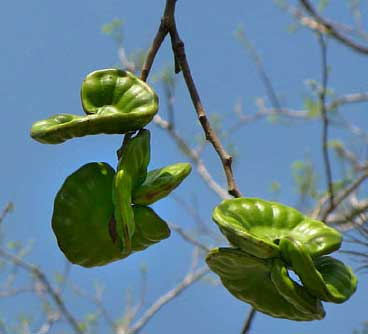
Sometimes you see especially big trees with elephantine trunks and massive, widely-spreading limbs bearing gardens of epiphytes such as bromeliads, aroids and orchids, such as those below:

Note that this tree doesn't have short, thick-based spines on its stems like Ceibas often do, nor is its trunk composed of several merging stems as often we see with the Strangler Figs; these species also can produce large trees with thick trunks. The species in the photo is one of the Yucatan's most eye-catching and memorable trees, yet it doesn't really have a commonly accepted English name. Sometimes people call it "Ear Tree" because of the shape of its legumes, but that sounds contrived. Guanacaste is sometimes used. That's a pretty name and we need a name, so that's what we'll use here. The Maya call it Piich. It's Enterolobium cyclocarpum. Farther south where there's more rain Guanacaste can grow up to 100 feet tall (30m).
Guanacaste's twice-compound leaves fall off during the dry season, littering the ground with confetti-like leaflets. Below you can see some leaves along with freshly emerged flower heads.

Toward the end of the dry season, in hot, breezy April or so, thick, woody, saucer-size, ear-shaped legume-type fruits appear bearing beans inside them that, when mature, can be roasted and ground to prepare a rich, flavorful, coffee-like drink.
